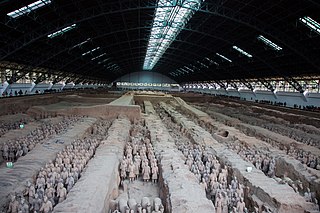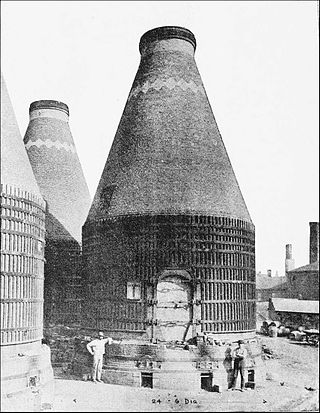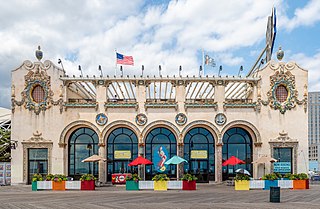See also
- Terracotta Army, ancient Chinese funerary warrior and horse statues
- Architectural terracotta
- Glazed architectural terra-cotta
- Terracotta roof tiles
Terra Cotta (or terracotta) is a clay-based ceramic material, and objects made in it.
Terra Cotta or terracotta may also refer to:

The Terracotta Army is a collection of terracotta sculptures depicting the armies of Qin Shi Huang, the first emperor of China. It is a form of funerary art buried with the emperor in 210–209 BCE with the purpose of protecting him in his afterlife.

Terracotta, also known as terra cotta or terra-cotta, is a term used in some contexts for earthenware. That is to say it is a clay-based unglazed or glazed non-vitreous ceramic, fired at relatively low temperatures.

Luca della Robbia was an Italian Renaissance sculptor from Florence. Della Robbia is noted for his colorful, tin-glazed terracotta statuary, a technique that he invented and passed on to his nephew Andrea della Robbia and great-nephews Giovanni della Robbia and Girolamo della Robbia. Although a leading sculptor in stone, after developing his technique in the early 1440s he worked primarily in terracotta. His large workshop produced both less expensive works cast from molds in multiple versions, and more expensive one-off individually modeled pieces.
Mather Tower is a Neo-Gothic, terra cotta-clad high-rise structure in Chicago, Illinois, United States. It is located at 75 East Wacker Drive in the downtown "loop" area, adjacent to the Chicago River.

Glazed architectural terra cotta is a ceramic masonry building material used as a decorative skin. It featured widely in the 'terracotta revival' from the 1880s until the 1930s. It was used in the UK, United States, Canada and Australia and is still one of the most common building materials found in U.S. urban environments. It is the glazed version of architectural terracotta; the material in both its glazed and unglazed versions is sturdy and relatively inexpensive, and can be molded into richly ornamented detail. Glazed terra-cotta played a significant role in architectural styles such as the Chicago School and Beaux-Arts architecture.

The Pui Tak Center, formerly known as the On Leong Merchants Association Building, is a building located in Chicago's Chinatown. Designed by architects Christian S. Michaelsen and Sigurd A. Rognstad, the building was built for the On Leong Merchants Association and opened in 1928. The Association used it as an immigrant assistance center, and the building was informally referred to as Chinatown's "city hall". In 1988, the FBI and Chicago Police raided the building as part of a racketeering investigation. The US federal government seized the building that same year.

The American Terracotta Tile and Ceramic Company was founded in 1881; originally as Spring Valley Tile Works; in Terra Cotta, Illinois, between Crystal Lake, Illinois and McHenry, Illinois near Chicago by William Day Gates. It became the country's first manufactury of architectural terracotta in 1889. The production consisted of drain tile, brick, chimney tops, finials, urns, and other economically fireproof building materials. Gates used the facilities to experiment with clays and glazes in an effort to design a line of art pottery which led to the introduction of Teco Pottery. American Terra Cotta's records are housed at the University of Minnesota and include original architectural drawings.
A Terra-Cotta Warrior, also known as Fight and Love with a Terracotta Warrior, is a 1989 Hong Kong film based on the novel by Lilian Lee, directed by Ching Siu-tung and produced by Tsui Hark, starring Zhang Yimou and Gong Li. The film is about a forbidden love between a court lady and a soldier of the Qin Dynasty. Gong Li plays the female protagonists Dong'er and Zhu Lili, and Zhang Yimou plays the terracotta warrior Meng Tianfang. This is one of the only two films where Zhang Yimou has a leading role, the other being Wu Tianming's Old Well. Warner Bros. has included the film in the catalogue of Warner Archive Collection.

Architectural terracotta refers to a fired mixture of clay and water that can be used in a non-structural, semi-structural, or structural capacity on the exterior or interior of a building. Terracotta pottery, as earthenware is called when not used for vessels, is an ancient building material that translates from Latin as "baked earth". Some architectural terracotta is actually stronger than stoneware. It can be unglazed, painted, slip glazed, or glazed. A piece of terracotta is composed of a hollow clay web enclosing a void space or cell. The cell can be installed in compression with mortar or hung with metal anchors; such cells are often partially backfilled with mortar.

The Federal Office Building, Seattle, Washington is a historic federal office building located at Seattle in King County, Washington.

The Foster Building, originally the Hotel Foster, is located on State Street in Schenectady, New York, United States. It is a commercial building in the Beaux-Arts architectural style.

The Potter Building is a building in the Financial District of Manhattan in New York City. The building occupies a full block along Beekman Street with the addresses 38 Park Row to its west and 145 Nassau Street to its east. It was designed by Norris G. Starkweather in a combination of the Queen Anne and neo-Grec styles, as an iron-framed structure.

Holy Trinity Platt Church, is in Platt Fields Park in Rusholme, Manchester, England. It is an active Anglican parish church in the deanery of Hulme, the archdeaconry of Manchester, and the diocese of Manchester. The church is recorded in the National Heritage List for England as a designated Grade II* listed building. It is the second "pot church" designed by Edmund Sharpe, so-called because the main building material used in the construction of the church is terracotta.

Perth Amboy Terra Cotta Company of Perth Amboy, New Jersey, was a late-nineteenth- and early twentieth-century brickworks, known for the manufacture of many prominent and unique architectural terracotta elements.

The Connally Building is located at 54 Peachtree Street in Downtown Atlanta, adjacent to the Underground Atlanta retail center. It is a work of architect William Lee Stoddart, completed in 1916. The building has been so extensively renovated that it bears little resemblance to the original design, other than the terra cotta façade on the lower stories. This was originally a six-story office building with a terracotta facade, which replaced an earlier Connally Building on the site. In 1990, eleven stories were added and it was converted into a hotel. It has operated under the names Howard Johnson Plaza Suites, University Place at Underground, The Suite Hotel at the Underground, and most recently it became a Fairfield Inn & Suites.

The Childs Restaurant Building on the Boardwalk is a New York City designated landmark on the Riegelmann Boardwalk at West 21st Street in Coney Island, Brooklyn, New York City. It was completed in 1923 for Childs Restaurants, an early restaurant chain and one of the largest in the United States at that time. It was designed in a "resort style with Spanish Revival influence" with colorful exterior terra cotta ornamentation that references its seaside location, with depictions of Poseidon, sailing ships, and sea creatures. It was a very large restaurant, with three stories and a roof garden.

John Marriott Blashfield (1811–1882) was a property developer and mosaic floor and ornamental terracotta manufacturer. He originally worked for the cement makers Wyatt, Parker and & Co in Millwall, but moved the business to Stamford in Lincolnshire in 1858, when it was renamed The Stamford Terracotta Company.
Terra Cotta is an unincorporated community in McHenry County, in the U.S. state of Illinois.

The Rocky Hill Historic District is a 176-acre (71 ha) historic district encompassing the historic core of the borough of Rocky Hill in Somerset County, New Jersey. The village is approximately one square mile and traces its beginnings to the 18th century, when George Washington stayed at Rockingham, and its major growth period to the second quarter of the 19th century. Located along Washington Street and Montgomery, Princeton, and Crescent Avenues, the district encompasses 145 buildings, only 12 of which are non-contributing, and has sustained its historic character without the intrusion of modern structures or parking lots. The most notable landmark in the village is Dutch Reformed Church, built in 1856 in the Carpenter Gothic style. The district was added to the National Register of Historic Places on July 8, 1982, for its significance in archeology, architecture and commerce.

Ely Walker Lofts is a building located at 1520 Washington Avenue in St. Louis, Missouri.